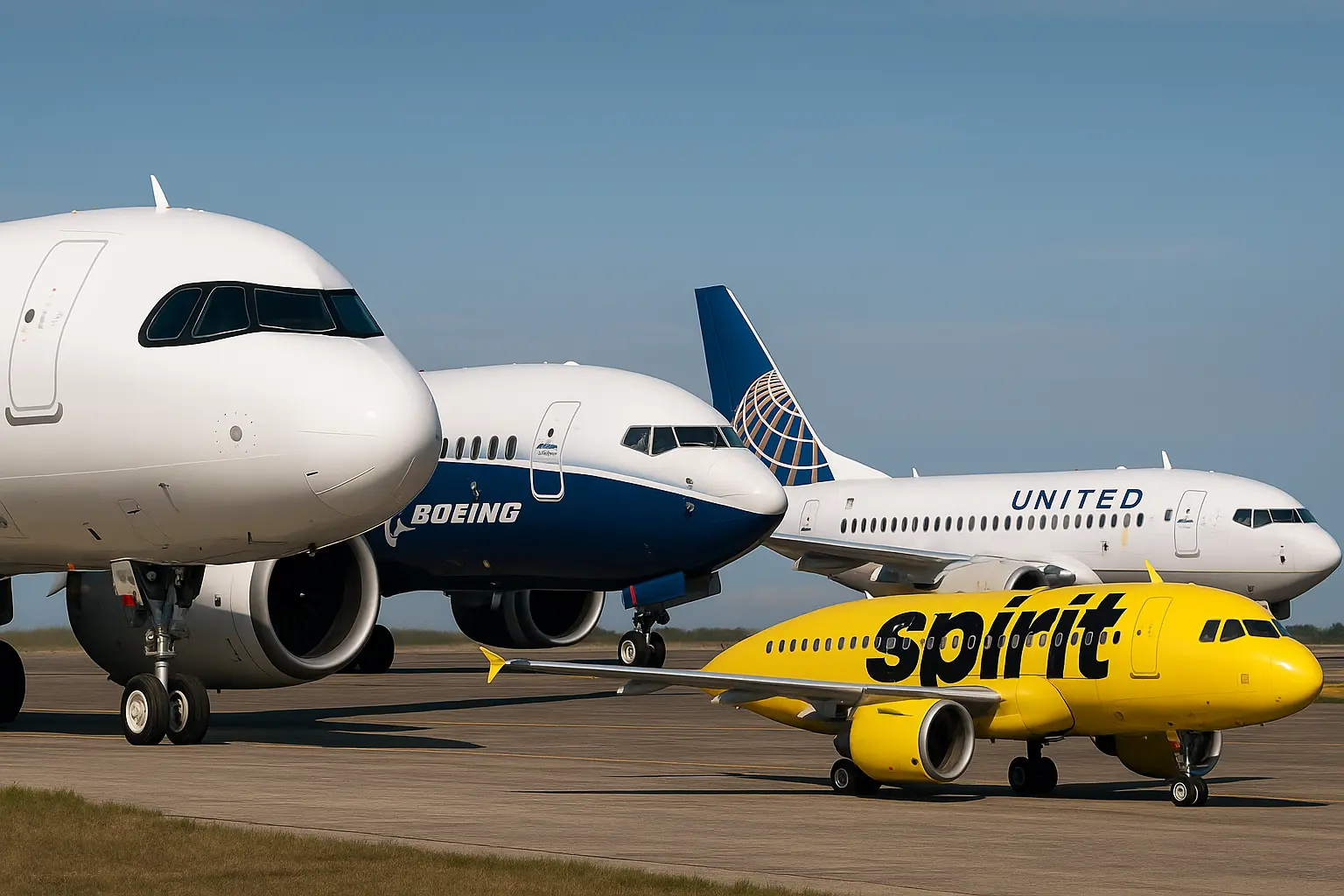The airline industry analysis 2025 shows an industry in flux, shaped by decades of innovation, competitive rivalries, and external disruptions. The global commercial aviation landscape is dominated by two major aircraft manufacturers—Airbus and Boeing—while airline operators like United Airlines and Spirit Airlines illustrate contrasting paths in adapting to evolving market demands.
Airbus has surged ahead of Boeing, capitalizing on its product strengths and manufacturing strategy. United Airlines is pursuing premium expansion to compete with Delta, while Spirit Airlines fights to adapt its ultra-low-cost carrier (ULCC) model in the face of economic and competitive pressures. Across the board, technological advancement, sustainability goals, and shifting consumer expectations are rewriting the rules of the game.
Table of Contents
Airbus vs Boeing: The Aircraft Manufacturing Showdown
Airbus’s Strategic Lead
In the airline industry analysis 2025, Airbus holds a dominant position, supplying over half of the world’s commercial aircraft orders and leading in profitability. Its A320 family, particularly the A321neo, has become the most sought-after narrow-body aircraft due to its fuel efficiency, extended range, and versatility in opening long, thin routes.
Airbus’s decision to expand its assembly footprint—building plants in the U.S., China, and Europe—has insulated it from supply chain risks and geopolitical disruptions. This flexibility also strengthens relationships with key airline customers worldwide.
Boeing’s Ongoing Struggles
Boeing’s troubles have persisted since the twin tragedies of the 737 Max crashes, compounded by certification delays, production quality issues, and reputational damage. Without a competitive alternative to the A321neo, Boeing is losing ground in the narrow-body market—historically the industry’s most lucrative segment.
The company’s more centralized manufacturing in North America has limited its agility compared to Airbus’s global approach, leaving Boeing more exposed to local supply chain bottlenecks.
(See also: Jobs of the Future: What AI Can’t Replace (Yet))
United Airlines: Targeting the Premium Market
Rising to Compete with Delta
United Airlines is one of the largest carriers in the world and a key case study in airline industry analysis 2025. While Delta is the profitability leader, United is aggressively expanding its international network and premium cabin offerings to close the gap.
Strategic mergers, notably with Continental Airlines, have given United a global reach. The airline is modernizing its fleet with fuel-efficient aircraft, adding Premium Plus and Economy Plus seating, and enhancing in-flight technology, such as faster Wi-Fi and upgraded entertainment systems.
Sustainability and Innovation
United is also investing in sustainable aviation fuels (SAF) and new aircraft technology as part of its broader environmental commitments. These moves are both a competitive differentiator and a response to increasing regulatory and consumer pressure to decarbonize air travel.
Spirit Airlines: The ULCC Model Under Pressure
Bankruptcy and Reinvention
Spirit Airlines once defined the ultra-low-cost carrier (ULCC) model in the U.S., offering rock-bottom base fares with à la carte fees for extras. But since 2019, rising costs, labor shortages, and supply chain delays have eroded profitability. In 2024, Spirit filed for Chapter 11 bankruptcy.
Competition from legacy carriers offering basic economy fares—often at similar prices but with more brand trust—has further squeezed Spirit’s market share.
Adjusting to Survive
Spirit is now experimenting with bundled fare options, new cabin tiers, and expanded route networks to remain relevant. Industry analysts note that the ULCC model is not disappearing—it is evolving. Success will hinge on adapting to consumer expectations while retaining cost discipline.
Hiring for Aviation in 2025?
Post pilot, cabin crew, MRO, and aerospace roles for free on WhatJobs and reach millions of qualified candidates.
👉 Post a Job Now →Shifts in Airline Cabin Strategy
Multi-Tier Revenue Models
The airline industry analysis 2025 reveals a growing emphasis on multi-tier cabin products. Airlines now segment their offerings from basic economy to premium economy, business, and first class, targeting every budget and maximizing revenue per seat.
Premium economy, in particular, is expanding rapidly, offering a balance between affordability and comfort that appeals to leisure travelers and small business clients.
Loyalty and Partnerships
Frequent flyer programs and co-branded credit cards remain powerful tools for customer retention. These programs integrate with cabin segmentation strategies to encourage upselling and repeat bookings.
Technological and Environmental Drivers
Sustainability as a Strategic Imperative
The aviation sector faces increasing regulatory pressure to reduce carbon emissions. Airlines and manufacturers are investing in sustainable aviation fuel, hybrid-electric propulsion, and lighter, more efficient aircraft.
Next-Generation Aircraft
Both Airbus and Boeing are expected to launch clean-sheet narrow-body designs in the next decade, incorporating digital flight systems, advanced aerodynamics, and alternative propulsion. Emerging players like China’s Comac and Brazil’s Embraer may disrupt the traditional duopoly, especially in regional and mid-range markets.
Globalization and Geopolitical Pressures
Airbus’s global manufacturing footprint allows it to navigate trade barriers and currency fluctuations more effectively. Boeing’s concentrated production, by contrast, leaves it more vulnerable to U.S. domestic economic shifts.
Meanwhile, geopolitical tensions—such as tariffs on aircraft imports or restrictions on parts exports—continue to influence the competitive balance between the two manufacturers.
Conclusion: The Next Decade in Aviation
The airline industry analysis 2025 paints a picture of transformation:
- Airbus leads in product and manufacturing strategy.
- Boeing faces urgent challenges to regain market share.
- United Airlines is climbing the premium ladder with global ambitions.
- Spirit Airlines is adapting its low-cost model to survive.
With sustainability, technology, and evolving customer expectations reshaping the competitive landscape, the winners will be those that innovate and adapt without losing sight of profitability.
FAQ – Airline Industry Analysis 2025
Q1: What does the airline industry analysis 2025 reveal about Airbus vs Boeing?
Airbus currently leads Boeing in market share and profitability, thanks to the A321neo’s efficiency and its global manufacturing strategy.
Q2: How is United Airlines competing in the airline industry analysis 2025?
United is expanding international routes, upgrading premium cabins, and investing in sustainability to challenge Delta’s dominance.
Q3: Why is Spirit Airlines struggling in the airline industry analysis 2025?
Spirit faces competition from basic economy fares, rising costs, and operational challenges, prompting a shift toward bundled fares and expanded service tiers.
Q4: What are the key trends shaping the airline industry analysis 2025?
Sustainability initiatives, cabin segmentation, emerging competitors like Comac, and technological innovation are driving change in the sector.




